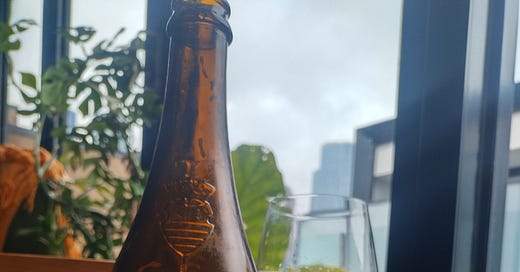I’ve been really off wine at the moment, or traditional wine, that is. As part of my exam preparations, I have to look at not only wine, but beer, spirits, sake, and amari. Alongside these studies, a colleague and I are rethinking the restaurant beer list and looking for exciting producers with vision and provenance.
So when I wandered past the bottle shop at Queen Victoria Market, looking for something to go with dinner tomorrow night (I’m not THAT off wine!), purchasing the Trappist Beer hidden in the back shelves was a no-brainer.
If you read last week's Weekly Tipple, you’ll remember that I prefer rich, textural beers. Oh boy, does the Trappist deliver. This tipple is 750ml of pure creamy, spicy goodness. It evokes images of whipped spiced cream and Madeira, and the scent of oak barrels. Its finish is refreshingly bitter after the intense clove and caramel front palette. At a hefty 10%, it’s one to drink with company or over a few days, much like a wine.
And why did the label “Trappist” catch my eye? For that, we’ll need a brief history lesson in beer-making.
A Moral Order
Our story begins with the Cistercian monks, who branched off from the Benedictine order in 1098, founding a new monastery in Citeaux near Dijon where they hoped to more closely follow the orders of Benedictine rule, which some felt had been compromised and liberalised by the Benedictines.
If you’re familiar with Cistercian monks, it may be because of Chablis. They are largely credited with making the region what it is today through their viticultural discoveries and sophisticated vinicultural techniques.
In 1664, some felt that the movement had again moved away from its original vision so a sub-order was created in the Cistercian monastery of La Trappe in Normandy. This was called the Strict Observance. This new order emphasised that monasteries should be economic and self-sustaining. Beer-brewing, a practice that had for centuries operated as a means of providing for the community, under The Strict Observance, became a way of sustaining the monastery and their charitable endeavours.
Labelling, Litigation, Lawsuits
Today there are 13 registered Trappist breweries, though only 10 are allowed to show the official Authentic Trappist Product certification on their label. To qualify for this stamp of authenticity, the beer must be made in or around the site of the abbey and made directly (or under the supervision of) monks/nuns of the order. Critically, all profits should be intended to support the monastery and its charities.
Naturally, with the growing popularity of these beers, fraudulent beers have arisen hoping to capitalise on the market appeal. In 1962, monks successfully sued one Belgian interloper for using the term “Trappist” on their beers.
The 13 Monasteries are spread across the globe, including countries like Spain and the US. Each Monastery must apply for Trappist status through the International Trappist Association.
Making Trappist Beer
The beers can be made in a range of styles but are typically top-fermented, bottle conditioned, and sit at a higher ABV.
Top fermenting is a more ancient form of brewing that applies yeast to the top of the brew at a higher temperature. This technique tends to yield more flavour through esters and phenols. Ales, for example, are top-fermented compared to lagers which are bottom-fermented at lower temperatures.
Conditioning effectively refers to how the beer is aged. This can be in oak casks, in tanks, or bottle. Bottle-conditioned beers go through a secondary bottle fermentation— much like champagne. A little bit of yeast and sugar is added to the finished beer which, once fermented, results in a soft, consistent fizz.
This process is hardly standardised. There are many different systems for showing strength and breweries will often use their own nomenclature. There are also varying degrees of market accessibility with some only accessible locally at the abbey and township, with others, like Chimay, being internationally sought after.
They’re Still Monks
Whilst researching this article, I came across a funny video by the channel DW Food. In their mini-documentary, they interview a Cistercian monk who seems fairly bewildered by their questions about beer. He makes a very interesting comment about the relationship between the Trappist beers and the Trappist movement:
“The whole raison d’etre here is monastic life. The church is at the centre of the monastery, not the brewery.”
It's very easy to fetishise monastic brews, from wine, to beer, to Chartreuse. But we mustn’t forget that these are deeply religious orders whose main focus is not necessarily on your coveted beverage of choice. I can imagine some monks feel like tourists and enthusiasts have very much missed the point, lost in a romantic fantasy of monastic life rather than meaningfully connecting with its values and beliefs.
So by all means, go out and drink some Trappist Beer: it’s delicious. But don’t forget that the romantic, prairie-prancing, cassock-wearing, bald-patch sporting monks you’re imagining are likely far more occupied with the divine than with your chalice of beer.



